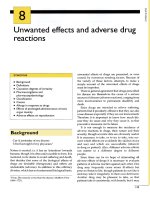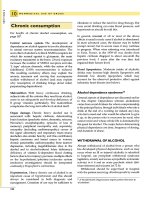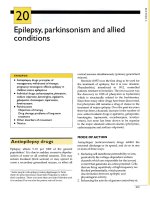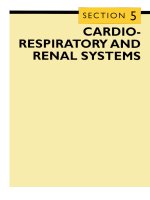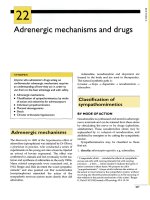CLINICAL TRIALS A Methodologic Perspective pdf
Bạn đang xem bản rút gọn của tài liệu. Xem và tải ngay bản đầy đủ của tài liệu tại đây (5.02 MB, 694 trang )
CLINICAL TRIALS
WILEY SERIES IN PROBABILITY AND STATISTICS
Established by WALTER A. SHEWHART and SAMUEL S. WILKS
Editors: David J. Balding, Noel A. C. Cressie, Nicholas I. Fisher,
Iain M. Johnstone, J. B. Kadane, Geert Molenberghs, Louise M. Ryan,
David W. Scott, Adrian F. M. Smith, Jozef L. Teugels
Editors Emeriti: Vic Barnett, J. Stuart Hunter, David G. Kendall
A complete list of the titles in this series appears at the end of this volume.
CLINICAL TRIALS
A Methodologic Perspective
Second Edition
STEVEN PIANTADOSI
Johns Hopkins School of Medicine, Baltimore, MD
A JOHN WILEY & SONS, INC., PUBLICATION
Copyright 2005 by John Wiley & Sons, Inc. All rights reserved.
Published by John Wiley & Sons, Inc., Hoboken, New Jersey.
Published simultaneously in Canada.
No part of this publication may be reproduced, stored in a retrieval system, or transmitted in any form or
by any means, electronic, mechanical, photocopying, recording, scanning, or otherwise, except as
permitted under Section 107 or 108 of the 1976 United States Copyright Act, without either the prior
written permission of the Publisher, or authorization through payment of the appropriate per-copy fee to
the Copyright Clearance Center, Inc., 222 Rosewood Drive, Danvers, MA 01923, 978-750-8400, fax
978-646-8600, or on the web at www.copyright.com. Requests to the Publisher for permission should be
addressed to the Permissions Department, John Wiley & Sons, Inc., 111 River Street, Hoboken, NJ 07030,
(201) 748-6011, fax (201) 748-6008.
Limit of Liability/Disclaimer of Warranty: While the publisher and author have used their best efforts in
preparing this book, they make no representations or warranties with respect to the accuracy or
completeness of the contents of this book and specifically disclaim any implied warranties of
merchantability or fitness for a particular purpose. No warranty may be created or extended by sales
representatives or written sales materials. The advice and strategies contained herein may not be suitable
for your situation. You should consult with a professional where appropriate. Neither the publisher nor
author shall be liable for any loss of profit or any other commercial damages, including but not limited to
special, incidental, consequential, or other damages.
For general information on our other products and services please contact our Customer Care Department
within the U.S. at 877-762-2974, outside the U.S. at 317-572-3993 or fax 317-572-4002.
Wiley also publishes its books in a variety of electronic formats. Some content that appears in print,
however, may not be available in electronic format.
Library of Congress Cataloging-in-Publication Data:
Piantadosi, Steven.
Clinical trials : a methodologic perspective / Steven Piantadosi—2nd ed.
p. ; cm. – (Wiley series in probability and statistics)
Includes bibliographical references and index.
ISBN-13: 978-0-471-72781-1 (cloth : alk. paper)
ISBN-10: 0-471-72781-4 (cloth : alk. paper)
1. Clinical trials—Statistical methods. I. Title. II. Series.
[DNLM: 1. Biomedical Research—methods. 2. Research—methods. 3. Clinical
Trials—methods. 4. Statistics—methods. W 20.5 P581c 2005]
R853.C55P53 2005
610 .72—dc22
2005040833
Printed in the United States of America.
10 9 8 7 6 5 4 3 2 1
CONTENTS
Preface
xxi
Preface to the First Edition
xxv
1
Preliminaries
1
1.1 Introduction, 1
1.2 Audience and Scope, 2
1.3 Other Sources of Knowledge, 4
1.3.1 Terminology, 5
1.3.2 Review of Notation and Terminology Is Helpful, 6
1.4 Examples, Data, and Programs, 6
1.5 Summary, 7
2
Clinical Trials as Research
9
2.1 Introduction, 9
2.1.1 Clinical Reasoning Is Based on the Case History, 10
2.1.2 Statistical Reasoning Emphasizes Inference Based on Designed
Data Production, 12
2.1.3 Clinical and Statistical Reasoning Converge in Research, 13
2.2 Defining Clinical Trials Formally, 14
2.2.1 Mixing of Clinical and Statistical Reasoning Is Recent, 14
2.2.2 Clinical Trials Are Rigorously Defined, 16
2.2.3 Experiments Can Be Misunderstood, 17
2.2.4 Clinical Trials as Science, 18
2.2.5 Trials and Statistical Methods Fit within a Spectrum of
Clinical Research, 19
v
vi
CONTENTS
2.3 Practicalities of Usage, 20
2.3.1 Predicates for a Trial, 20
2.3.2 Trials Can Provide Confirmatory Evidence, 20
2.3.3 Clinical Trials Are Unwieldy, Messy, and Reliable, 21
2.3.4 Other Methods Are Valid for Making Some Clinical
Inferences, 23
2.3.5 Trials Are Difficult to Apply in Some Circumstances, 25
2.3.6 Randomized Studies Can Be Initiated Early, 25
2.4 Summary, 26
2.5 Questions for Discussion, 26
3
Why Clinical Trials Are Ethical
3.1 Introduction, 29
3.1.1 Science and Ethics Share Objectives, 30
3.1.2 Equipoise and Uncertainty, 31
3.2 Duality, 32
3.2.1 Clinical Trials Sharpen, but Do Not Create, the Issue, 32
3.2.2 A Gene Therapy Tragedy Illustrates Duality, 32
3.2.3 Research and Practice Are Convergent, 33
3.2.4 The Hippocratic Tradition Does Not Proscribe Clinical
Trials, 36
3.2.5 Physicians Always Have Multiple Roles, 38
3.3 Historically Derived Principles of Ethics, 41
3.3.1 Nuremberg Contributed an Awareness of the Worst Problems, 41
3.3.2 High-Profile Mistakes Were Made in the United States, 42
3.3.3 The Helsinki Declaration Was Widely Adopted, 42
3.3.4 Other International Guidelines Have Been Proposed, 44
3.3.5 Institutional Review Boards Provide Ethical Oversight, 45
3.3.6 Ethical Principles Relevant to Clinical Trials, 46
3.4 Contemporary Foundational Principles, 48
3.4.1 Collaborative Partnership, 48
3.4.2 Scientific Value, 49
3.4.3 Scientific Validity, 49
3.4.4 Fair Subject Selection, 49
3.4.5 Favorable Risk–Benefit, 50
3.4.6 Independent Review, 50
3.4.7 Informed Consent, 51
3.4.8 Respect for Subjects, 52
3.5 Methodologic Reflections, 53
3.5.1 Practice Based on Unproven Treatments Is Not Ethical, 53
3.5.2 Ethics Considerations Are Important Determinants of Design, 55
3.5.3 Specific Methods Have Justification, 57
29
CONTENTS
vii
3.6 Professional Conduct, 59
3.6.1 Conflict of Interest, 59
3.6.2 Professional Statistical Ethics, 61
3.7 Summary, 63
3.8 Questions for Discussion, 63
4
Contexts for Clinical Trials
65
4.1 Introduction, 65
4.1.1 Some Ways to Learn about Trials in a Given Context, 66
4.1.2 Issues of Context, 67
4.2 Drugs, 68
4.2.1 Are Drugs Special?, 70
4.2.2 Why Trials Are Used Extensively for Drugs, 71
4.3 Devices, 72
4.3.1 Use of Trials for Medical Devices, 73
4.3.2 Are Devices Different from Drugs?, 74
4.3.3 Case Study, 76
4.4 Prevention, 76
4.4.1 The Prevention versus Therapy Dichotomy Is Overworked, 77
4.4.2 Vaccines and Biologicals, 78
4.4.3 A Perspective on Risk–Benefit, 79
4.4.4 Methodology and Framework for Prevention Trials, 81
4.5 Complementary and Alternative Medicine, 82
4.5.1 The Essential Paradox of CAM and Clinical Trials, 84
4.5.2 Why Trials Have Not Been Used Extensively in CAM, 85
4.5.3 Some Principles for Rigorous Evaluation, 87
4.6 Surgery and Skill-Dependent Therapies, 88
4.6.1 Why Trials Have Not Been Used Extensively in Surgery, 90
4.6.2 Reasons Why Some Surgical Therapies Require Less Rigorous Study Designs, 92
4.6.3 Sources of Variation, 92
4.6.4 Difficulties of Inference, 93
4.6.5 Control of Observer Bias Is Possible, 94
4.6.6 Illustrations from an Emphysema Surgery Trial, 95
4.7 A Brief View of Some Other Contexts, 101
4.7.1 Screening Trials, 101
4.7.2 Diagnostic Trials, 103
4.7.3 Radiotherapy, 103
4.8 Summary, 104
4.9 Questions for Discussion, 105
5
Statistical Perspectives
5.1 Introduction, 107
107
viii
CONTENTS
5.2 Differences in Statistical Perspectives, 108
5.2.1 Models and Parameters, 108
5.2.2 Philosophy of Inference Divides Statisticians, 108
5.2.3 Resolution, 109
5.2.4 Points of Agreement, 110
5.3 Frequentist, 112
5.3.1 Binomial Case Study, 113
5.3.2 Other Issues, 114
5.4 Bayesian, 115
5.4.1 Choice of a Prior Distribution Is a Source of Contention, 116
5.4.2 Binomial Case Study, 117
5.4.3 Bayesian Inference Is Different, 119
5.5 Likelihood, 120
5.5.1 Binomial Case Study, 121
5.5.2 Likelihood-Based Design, 122
5.6 Afterthoughts, 123
5.6.1 Statistical Procedures Are Not Standardized, 123
5.6.2 Practical Controversies Related to Statistics Exist, 123
5.7 Summary, 125
5.8 Questions for Discussion, 125
6
Clinical Trials as Experimental Designs
6.1 Introduction, 127
6.1.1 Trials Are Relatively Simple Experimental Designs, 128
6.1.2 Study Design Is Critical for Inference, 129
6.2 Goals of Experimental Design, 129
6.2.1 Control of Random Error and Bias Is the Goal, 129
6.2.2 Conceptual Simplicity Is Also a Goal, 130
6.2.3 Encapsulation of Subjectivity, 131
6.2.4 Leech Case Study, 131
6.3 Trial Terminology, 132
6.3.1 Drug Development Traditionally Recognizes Four Trial
Designs, 132
6.3.2 Descriptive Terminology Is Broader and Recognizes More
Types of Trials, 133
6.4 Design Concepts, 134
6.4.1 The Foundations of Design Are Observation and Theory, 134
6.4.2 A Lesson from the Women’s Health Initiative, 136
6.4.3 Experiments Use Three Components of Design, 137
6.5 Survey of Developmental Trial Designs, 143
6.5.1 Early Development, 143
6.5.2 Middle Development, 144
6.5.3 Late Development, 148
127
CONTENTS
ix
6.6 Special
6.6.1
6.6.2
6.6.3
6.6.4
6.6.5
Design Issues, 151
Placebos, 151
Equivalence or Noninferiority, 154
Nonuniformity of Effect, 154
Randomized Discontinuation, 155
Hybrid Designs May Be Needed for Resolving Special
Questions, 156
6.6.6 Clinical Trials Cannot Meet Some Objectives, 156
6.7 Importance of the Protocol Document, 157
6.7.1 Protocols Have Many Functions, 158
6.7.2 Deviations from Protocol Specifications Are Common, 159
6.7.3 Protocols Are Structured, Logical, and Complete, 160
6.8 Summary, 164
6.9 Questions for Discussion, 165
7
Random Error and Bias
167
7.1 Introduction, 167
7.2 Random Error, 169
7.2.1 Hypothesis Tests versus Significance Tests, 169
7.2.2 Hypothesis Tests Are Subject to Two Types of Random
Error, 170
7.2.3 Type I Errors Are Relatively Easy to Control, 171
7.2.4 The Properties of Confidence Intervals Are Similar, 171
7.2.5 Using a One- or Two-Sided Hypothesis Test Is Not the
Right Question, 172
7.2.6 P -Values Quantify the Type I Error, 173
7.2.7 Type II Errors Depend on the Clinical Difference of
Interest, 173
7.2.8 Post hoc Power Calculations Are not Helpful, 175
7.3 Clinical Biases, 176
7.3.1 Relative Size of Random Error and Bias Is Important, 176
7.3.2 Bias Arises from Numerous Sources, 176
7.3.3 Controlling Structural Bias Is Conceptually Simple, 179
7.4 Statistical Bias, 182
7.4.1 Some Statistical Bias Can Be Corrected, 183
7.4.2 Unbiasedness Is Not the Only Desirable Attribute of an
Estimator, 183
7.5 Summary, 185
7.6 Questions for Discussion, 185
8
Objectives and Outcomes
8.1 Introduction, 187
187
x
CONTENTS
8.2 Objectives, 188
8.2.1 Estimation Is the Most Common Objective, 188
8.2.2 Selection Can Also Be an Objective, 189
8.2.3 Objectives Require Various Scales of Measurement, 189
8.3 Outcomes, 190
8.3.1 Mixed Outcomes and Predictors, 190
8.3.2 Criteria for Evaluating Outcomes, 191
8.3.3 Prefer “Hard” or Objective Outcomes, 191
8.3.4 Outcomes Can Be Quantitative or Qualitative, 192
8.3.5 Measures Are Useful and Efficient Outcomes, 192
8.3.6 Some Outcomes Are Summarized as Counts, 193
8.3.7 Ordered Categories Are Commonly Used for Severity or
Toxicity, 193
8.3.8 Unordered Categories Are Sometimes Used, 193
8.3.9 Dichotomies Are Simple Summaries, 194
8.3.10 Event Times May Be Censored, 194
8.3.11 Event Time Data Require Two Numerical Values, 196
8.3.12 Censoring and Lost to Follow-up Are Not the Same, 197
8.3.13 Survival and Disease Progression, 198
8.3.14 Composite Outcomes Instead of Censoring, 199
8.3.15 Waiting for Good Events Complicates Censoring, 199
8.4 Surrogate Outcomes, 200
8.4.1 Surrogate Outcomes Are Disease-Specific, 201
8.4.2 Surrogate Outcomes Can Make Trials More Efficient, 204
8.4.3 Surrogate Outcomes Have Significant Limitations, 205
8.5 Some Special Endpoints, 207
8.5.1 Repeated Measurements Are not Common in Clinical Trials, 207
8.5.2 Patient Reported Outcomes, 207
8.6 Summary, 208
8.7 Questions for Discussion, 209
9
Translational Clinical Trials
9.1 Introduction, 211
9.1.1 Translational Setting and Outcomes, 212
9.1.2 Character and Definition, 213
9.1.3 Small Does Not Mean Translational, 214
9.2 Information from Translational Trials, 214
9.2.1 Parameter Uncertainty versus Outcome Uncertainty, 214
9.2.2 Entropy, 215
9.2.3 Empirical Entropy Is Biased, 216
9.2.4 Variance, 216
9.2.5 Sample Size for Translational Trials, 218
211
CONTENTS
xi
9.3 Summary, 220
9.4 Questions for Discussion, 221
10 Dose-Finding Designs
223
10.1 Introduction, 223
10.2 Principles, 224
10.2.1 What Does “Phase I” Mean?, 224
10.2.2 Distinguish Dose–Safety from Dose–Efficacy, 226
10.2.3 Dose Optimality Is a Design Definition, 226
10.2.4 The General Dose-Finding Problem Is Unsolved, 227
10.2.5 Unavoidable Subjectivity, 228
10.2.6 Sample Size Is an Outcome of Dose-Finding Studies, 229
10.2.7 Idealized Dose-Finding Design, 229
10.3 Fibonacci and Related Dose-Ranging, 230
10.3.1 Some Historical Designs, 231
10.3.2 Typical Design, 231
10.3.3 Operating Characteristics Can Be Calculated, 232
10.3.4 Modifications, Strengths, and Weaknesses, 234
10.4 Designs Used for Dose-Finding, 236
10.4.1 Mathematical Models Facilitate Inferences, 236
10.4.2 Continual Reassessment Method, 237
10.4.3 Pharmacokinetic Measurements Might Be Used to Improve
CRM Dose Escalations, 240
10.4.4 The CRM Is an Attractive Design to Criticize, 241
10.4.5 CRM Example, 241
10.4.6 Can Randomization Be Used in Phase I or TM Trials?, 242
10.4.7 Phase I Data Have Other Uses, 242
10.5 More General Dose-Finding Issues, 242
10.5.1 Dose-Finding Is Not Always One Dimensional, 243
10.5.2 Dual Dose-Finding, 244
10.5.3 Optimizing Safety and Efficacy Jointly, 247
10.6 Summary, 250
10.7 Questions for Discussion, 250
11 Sample Size and Power
11.1 Introduction, 251
11.2 Principles, 252
11.2.1 What Is Precision?, 253
11.2.2 What Is Power?, 253
11.2.3 What Is Evidence?, 254
11.2.4 Sample Size and Power Calculations Are Approximations, 255
11.2.5 The Relationship between Power/Precision and Sample Size
Is Quadratic, 256
251
xii
CONTENTS
11.3 Early Developmental Trials, 256
11.3.1 Translational Trials, 256
11.3.2 Dose-Finding Trials, 258
11.4 Safety and Activity Studies, 258
11.4.1 Simple SA Designs Can Use Fixed Sample Size, 259
11.4.2 Exact Binomial Confidence Limits Are Helpful, 260
11.4.3 Bayesian Binomial Confidence Intervals, 263
11.4.4 A Bayesian Approach Can Use Prior Information, 264
11.4.5 Likelihood-Based Approach for Proportions, 266
11.4.6 Confidence Intervals for a Mean Provide a Sample Size
Approach, 267
11.4.7 Confidence Intervals for Event Rates Can Determine
Sample Size, 268
11.4.8 Likelihood-Based Approach for Event Rates, 271
11.4.9 Ineffective or Unsafe Treatments Should Be Discarded
Early, 271
11.4.10 Two-Stage Designs Are Efficient, 272
11.4.11 Randomized SA Trials, 273
11.5 Comparative Trials, 277
11.5.1 How to Choose Type I and II Error Rates, 277
11.5.2 Comparisons Using the t-Test Are a Good Learning
Example, 278
11.5.3 Likelihood-Based Approach, 280
11.5.4 Dichotomous Responses Are More Complex, 282
11.5.5 Hazard Comparisons Yield Similar Equations, 283
11.5.6 Parametric and Nonparametric Equations Are Connected, 286
11.5.7 Accommodating Unbalanced Treatment Assignments, 286
11.5.8 A Simple Accrual Model Can Also Be Incorporated, 288
11.5.9 Noninferiority, 290
11.6 ES Trials, 295
11.6.1 Model Rare Events with the Poisson Distribution, 295
11.6.2 Likelihood Approach for Poisson Rates, 296
11.7 Other Considerations, 297
11.7.1 Cluster Randomization Requires Increased Sample Size, 297
11.7.2 Simple Cost Optimization, 298
11.7.3 Increase the Sample Size for Nonadherence, 299
11.7.4 Simulated Lifetables Can Be a Simple Design Tool, 301
11.7.5 Sample Size for Prognostic Factor Studies, 302
11.7.6 Computer Programs Simplify Calculations, 303
11.7.7 Simulation Is a Powerful and Flexible Design Alternative, 304
11.7.8 Power Curves are Sigmoid Shaped, 304
11.8 Summary, 305
11.9 Questions for Discussion, 306
CONTENTS
12 The Study Cohort
xiii
309
12.1 Introduction, 309
12.2 Defining the Study Cohort, 310
12.2.1 Active Sampling or Enrichment, 310
12.2.2 Participation May Select Subjects with Better Prognosis, 311
12.2.3 Define the Study Population Using Eligibility and
Exclusion Criteria, 314
12.2.4 Quantitative Selection Criteria versus False Precision, 316
12.2.5 Comparative Trials Are Not Sensitive to Selection, 317
12.3 Anticipating Accrual, 318
12.3.1 Using a Run-in Period, 318
12.3.2 Estimate Accrual Quantitatively, 319
12.4 Inclusiveness, Representation, and Interactions, 322
12.4.1 Inclusiveness Is a Worthy Goal, 322
12.4.2 Barriers Can Hinder Trial Participation, 322
12.4.3 Efficacy versus Effectiveness Trials, 323
12.4.4 Representation: Politics Blunders into Science, 324
12.5 Summary, 329
12.6 Questions for Discussion, 330
13 Treatment Allocation
13.1 Introduction, 331
13.2 Randomization, 332
13.2.1 Randomization Controls the Influence of Unknown Factors, 333
13.2.2 Haphazard Assignments Are Not Random, 335
13.2.3 Simple Randomization Can Yield Imbalances, 335
13.3 Constrained Randomization, 336
13.3.1 Blocking Improves Balance, 336
13.3.2 Blocking and Stratifying Balances Prognostic Factors, 337
13.3.3 Other Considerations Regarding Blocking, 339
13.4 Adaptive Allocation, 340
13.4.1 Urn Designs Also Improve Balance, 340
13.4.2 Minimization Yields Tight Balance, 341
13.4.3 Play the Winner, 342
13.5 Other Issues Regarding Randomization, 343
13.5.1 Administration of the Randomization, 343
13.5.2 Computers Generate Pseudorandom Numbers, 345
13.5.3 Randomization Justifies Type I Errors, 345
13.6 Unequal Treatment Allocation, 349
13.6.1 Subsets May Be of Interest, 350
13.6.2 Treatments May Differ Greatly in Cost, 350
13.6.3 Variances May Be Different, 350
331
xiv
CONTENTS
13.7 Randomization before Consent, 351
13.8 Summary, 352
13.9 Questions for Discussion, 352
14 Treatment Effects Monitoring
355
14.1 Introduction, 355
14.1.1 Motives for Monitoring, 356
14.1.2 Components of Responsible Monitoring, 357
14.1.3 Trials Can Be Stopped for a Variety of Reasons, 357
14.1.4 There Is Tension in the Decision to Stop, 358
14.2 Administrative Issues in Trial Monitoring, 359
14.2.1 Monitoring of Single-Center Studies Relies on Periodic
Investigator Reporting, 360
14.2.2 Composition and Organization of the TEMC, 361
14.2.3 Complete Objectivity Is Not Ethical, 364
14.3 Organizational Issues Related to Data, 366
14.3.1 The TEMC Assesses Baseline Comparability, 366
14.3.2 The TEMC Reviews Accrual and Expected Time to Study
Completion, 367
14.3.3 Timeliness of Data and Reporting Lags, 367
14.3.4 Data Quality Is a Major Focus of the TEMC, 368
14.3.5 The TEMC Reviews Safety and Toxicity Data, 368
14.3.6 Efficacy Differences Are Assessed by the TEMC, 369
14.3.7 The TEMC Should Address a Few Practical Questions
Specifically, 369
14.3.8 The TEMC Mechanism Has Potential Weaknesses, 371
14.4 Statistical Methods for Monitoring, 371
14.4.1 There Are Several Approaches to Evaluating Incomplete
Evidence, 371
14.4.2 Likelihood Methods, 373
14.4.3 Bayesian Methods, 378
14.4.4 Decision-Theoretic Methods, 381
14.4.5 Frequentist Methods, 381
14.4.6 Other Monitoring Tools, 387
14.4.7 Some Software, 392
14.5 Summary, 392
14.6 Questions for Discussion, 393
15 Counting Subjects and Events
15.1 Introduction, 395
15.2 Nature of Some Specific Data Imperfections, 396
15.2.1 Evaluability Criteria Are a Methodologic Error, 397
395
CONTENTS
xv
15.2.2 Statistical Methods Can Cope with Some Types of Missing
Data, 398
15.2.3 Protocol Nonadherence Is Common, 400
15.3 Treatment Nonadherence, 402
15.3.1 Intention to Treat Is a Policy of Inclusion, 402
15.3.2 Coronary Drug Project Results Illustrate the Pitfalls of
Exclusions based on Nonadherence, 403
15.3.3 Statistical Studies Support the ITT Approach, 403
15.3.4 Trials Can Be Viewed as Tests of Treatment Policy, 404
15.3.5 ITT Analyses Cannot Always Be Applied, 404
15.3.6 Trial Inferences Depend on the Experimental Design, 406
15.4 Summary, 406
15.5 Questions for Discussion, 407
16 Estimating Clinical Effects
16.1 Introduction, 409
16.1.1 Structure Aids Data Interpretation, 410
16.1.2 Estimates of Risk Are Natural and Useful, 411
16.2 Dose-Finding and PK Trials, 412
16.2.1 Pharmacokinetic Models Are Essential for Analyzing DF
Trials, 412
16.2.2 A Two-Compartment Model Is Simple but Realistic, 413
16.2.3 PK Models Are Used by “Model Fitting”, 416
16.3 SA Studies, 417
16.3.1 Mesothelioma Clinical Trial Example, 417
16.3.2 Summarize Risk for Dichotomous Factors, 418
16.3.3 Nonparametric Estimates of Survival
Are Robust, 420
16.3.4 Parametric (Exponential) Summaries of Survival Are Efficient, 421
16.4 Comparative Efficacy Trials (Phase III), 423
16.4.1 Examples of CTE Trials Used in This Section, 424
16.4.2 Continuous Measures Estimate Treatment Differences, 426
16.4.3 Baseline Measurements Can Increase Precision, 426
16.4.4 Nonparametric Survival Comparisons, 427
16.4.5 Risk (Hazard) Ratios and Confidence Intervals Are Clinically Useful Data Summaries, 429
16.4.6 Statistical Models Are Helpful Tools, 431
16.4.7 P -Values Do Not Measure Evidence, 432
16.5 Strength of Evidence through Support Intervals, 434
16.5.1 Support Intervals Are Based on the Likelihood Function, 434
16.5.2 Support Intervals Can Be Used with Any Outcome, 435
16.6 Special Methods of Analysis, 436
409
xvi
CONTENTS
16.6.1 The Bootstrap Is Based on Resampling, 437
16.6.2 Some Clinical Questions Require Other Special Methods
of Analysis, 438
16.7 Exploratory or Hypothesis-Generating Analyses, 442
16.7.1 Clinical Trial Data Lend Themselves to Exploratory Analyses, 442
16.7.2 Multiple Tests Multiply Type I Errors, 442
16.7.3 Kinds of Multiplicity, 443
16.7.4 Subgroup Analyses Are Error Prone, 443
16.8 Summary, 446
16.9 Questions for Discussion, 447
17 Prognostic Factor Analyses
453
17.1 Introduction, 453
17.1.1 Studying Prognostic Factors Is Broadly Useful, 454
17.1.2 Prognostic Factors Can Be Constant or Time-Varying, 455
17.2 Model-Based Methods, 456
17.2.1 Models Combine Theory and Data, 456
17.2.2 The Scale of Measurements (Coding) May Be Important, 457
17.2.3 Use Flexible Covariate Models, 457
17.2.4 Building Parsimonious Models Is the Next Step, 459
17.2.5 Incompletely Specified Models May Yield Biased Estimates, 464
17.2.6 Study Second-Order Effects (Interactions), 465
17.2.7 PFAs Can Help Describe Risk Groups, 466
17.2.8 Power and Sample Size for PFAs, 470
17.3 Adjusted Analyses of Comparative Trials, 470
17.3.1 What Should We Adjust For?, 471
17.3.2 What Can Happen?, 472
17.4 Non–Model-Based Methods for PFAs, 475
17.4.1 Recursive Partitioning Uses Dichotomies, 475
17.4.2 Neural Networks Are Used for Pattern Recognition, 476
17.5 Summary, 477
17.6 Questions for Discussion, 478
18 Reporting and Authorship
18.1 Introduction, 479
18.2 General Issues in Reporting, 480
18.2.1 Uniformity of Reporting Can Improve Comprehension, 481
18.2.2 Quality of the Literature, 482
18.2.3 Peer Review Is the Only Game in Town, 482
18.2.4 Publication Bias Can Distort Impressions Based on the
Literature, 483
18.3 Clinical Trial Reports, 484
479
CONTENTS
18.4
18.5
18.6
18.7
xvii
18.3.1 General Considerations, 485
18.3.2 Employ a Complete Outline for CTE Reporting, 490
Authorship, 494
18.4.1 Inclusion and Ordering, 495
18.4.2 Responsibility of Authorship, 496
18.4.3 Authorship Models, 496
18.4.4 Some Other Practicalities, 498
Alternative Ways to Disseminate Results, 499
Summary, 499
Questions for Discussion, 500
19 Factorial Designs
501
19.1 Introduction, 501
19.2 Characteristics of Factorial Designs, 502
19.2.1 Interactions or Efficiency, but Not Both Simultaneously, 502
19.2.2 Factorial Designs Are Defined by Their Structure, 502
19.2.3 Factorial Designs Can Be Made Efficient, 504
19.3 Treatment Interactions, 505
19.3.1 Factorial Designs Are the Only Way to Study Interactions, 505
19.3.2 Interactions Depend on the Scale of Measurement, 507
19.3.3 The Interpretation of Main Effects Depends on Interactions, 507
19.3.4 Analyses Can Employ Linear Models, 508
19.4 Examples of Factorial Designs, 509
19.5 Partial, Fractional, and Incomplete Factorials, 511
19.5.1 Use Partial Factorial Designs When Interactions Are Absent, 511
19.5.2 Incomplete Designs Present Special Problems, 512
19.6 Summary, 512
19.7 Questions for Discussion, 513
20 Crossover Designs
20.1 Introduction, 515
20.1.1 Other Ways of Giving Multiple Treatments Are Not
Crossovers, 516
20.1.2 Treatment Periods May Be Randomly Assigned, 516
20.2 Advantages and Disadvantages, 517
20.2.1 Crossover Designs Can Increase Precision, 517
20.2.2 A Crossover Design Might Improve Recruitment, 518
20.2.3 Carryover Effects Are a Potential Problem, 518
20.2.4 Dropouts Have Strong Effects, 519
20.2.5 Analysis Is More Complex Than Parallel-Groups Designs, 519
20.2.6 Prerequisites Are Needed to Apply Crossover Designs, 520
20.3 Analysis, 520
515
xviii
CONTENTS
20.3.1 Analysis Can Be Based on a Cell Means Model, 521
20.3.2 Other Issues in Analysis, 525
20.3.3 Classic Case Study, 525
20.4 Summary, 526
20.5 Questions for Discussion, 527
21 Meta-Analyses
529
21.1 Introduction, 529
21.1.1 Meta-Analyses Formalize Synthesis and Increase Precision, 530
21.2 A Sketch of Meta-Analysis Methods, 531
21.2.1 Meta-Analysis Necessitates Prerequisites, 531
21.2.2 Many Studies Are Potentially Relevant, 532
21.2.3 Select Studies, 533
21.2.4 Plan the Statistical Analysis, 533
21.2.5 Summarize the Data Using Observed and Expected, 534
21.3 Other Issues, 536
21.3.1 Meta-Analyses Have Practical and Theoretical Limitations, 536
21.3.2 Meta-Analysis Has Taught Useful Lessons, 537
21.4 Summary, 537
21.5 Questions for Discussion, 538
22 Misconduct and Fraud in Clinical Research
22.1 Introduction, 539
22.1.1 Integrity and Accountability Are Critically Important, 540
22.1.2 Fraud and Misconduct Are Difficult to Define, 541
22.2 Research Practices, 544
22.2.1 Misconduct Has Been Uncommon, 545
22.2.2 Causes of Misconduct, 546
22.3 General Approach to Allegations of Misconduct, 547
22.3.1 Government, 547
22.3.2 Institutions, 549
22.3.3 Problem Areas, 550
22.4 Characteristics of Some Misconduct Cases, 551
22.4.1 Darsee Case, 551
22.4.2 Poisson (NSABP) Case, 553
22.4.3 Two Recent Cases from Germany, 556
22.5 Lessons, 557
22.5.1 Recognizing Fraud or Misconduct, 557
22.5.2 Misconduct Cases Yield Other Lessons, 559
22.6 Clinical Investigators’ Responsibilities, 560
22.6.1 General Responsibilities, 560
22.6.2 Additional Responsibilities Related to INDs, 561
22.6.3 Sponsor Responsibilities, 562
539
CONTENTS
xix
22.7 Summary, 562
22.8 Questions for Discussion, 563
Appendices
A
Data and Programs
565
A.1 Introduction, 565
A.2 Data, 566
A.3 Design Programs, 566
A.3.1 Power and Sample Size Program, 566
A.3.2 Blocked Stratified Randomization, 567
A.3.3 Continual Reassessment Method, 567
A.4 Mathematica Code, 567
B
Notation and Terminology
569
B.1 Introduction, 569
B.2 Notation, 569
B.2.1 Greek Letters, 570
B.2.2 Roman Letters, 571
B.2.3 Other Symbols, 572
B.3 Terminology and Concepts, 572
C
Abbreviations
587
D
Nuremberg Code
591
E
Declaration of Helsinki
593
E.1 Introduction, 593
E.2 Basic Principles for All Medical Research, 594
F
NCI Data and Safety Monitoring Policy
F.1
F.2
F.3
F.4
F.5
F.6
F.7
F.8
F.9
F.10
Introduction, 599
Responsibility for Data and Safety Monitoring, 599
Requirement for Data and Safety Monitoring Boards, 600
Responsibilities of the DSMB, 600
Membership, 600
Meetings, 601
Recommendations from the DSMB, 601
Release of Outcome Data, 602
Confidentiality Procedures, 602
Conflict of Interest, 602
599
xx
G
CONTENTS
NIH Data and Safety Monitoring Policy
G.1
G.2
G.3
G.4
G.5
G.6
H
605
Background, 605
Principles of Monitoring Data and Safety, 606
Practical and Implementation Issues: Oversight of Monitoring, 606
Institutes and Centers Responsibilities, 606
Performance of Data and Safety Monitoring, 607
Examples of Monitoring Operations, 608
Royal Statistical Society Code of Conduct
609
H.1 Introduction, 609
H.2 Constitutional Authority, 609
H.3 Rules of Professional Conduct, 609
H.3.1 The Public Interest, 610
H.3.2 Duty to Employers and Clients, 610
H.3.3 Duty to the Profession, 610
H.3.4 Disciplinary Procedures, 611
Bibliography
613
Author Index
659
Subject Index
675
PREFACE
A respectable period of time has passed since the first edition of this book, during which
several pressures have necessitated a second edition. Most important, there were the
inadvertent errors needing correction. The field has also had some significant changes,
not so much in methodology perhaps as in context, regulation, and the like. I can say
some things more clearly now than previously because many issues are better defined
or I care more (or less) about how the discussion will be received.
I have added much new material covering some gaps (and therefore some new
mistakes), but always hoping to make learning easier. The result is too much to cover
in the period that I usually teach—one academic quarter. It may be appropriate for a
semester course. Many students tell me that they consult this book as a reference, so
the extra material should ultimately be useful.
Many colleagues have been kind enough to give their valuable time to review drafts
of chapters, despite apparently violating Nabokov’s advice: “Only ambitious nonentities and hearty mediocrities exhibit their rough drafts. It is like passing around samples
of one’s sputum.” Nevertheless, I am grateful to Elizabeth Garrett-Mayer, Ph.D., Bonnie Piantadosi, M.S.W, M.H.S., Anne Piantadosi, Irene Roach, Pamela Scott, Ph.D.,
Gail Weinmann, M.D., and Xiaobu Ye, M.D., M.S. for such help. Chris Szekely,
Ph.D. reviewed many chapters and references in detail. Sean Roach, M.L.S. and Alisa
Moore provided valuable assistance with references. Alla Guseynova, M.S. reviewed
and corrected the computational code for the book.
As usual, students in my class Design and Analysis of Clinical Trials offered through
the Hopkins Department of Biostatistics and the Graduate Training Program in Clinical
Investigation provide the best motivation for writing this book by virtue of their lively
discussion and questions. I would also like to thank the faculties, students, and sponsors from the AACR/ASCO Vail Workshop, as well as the sister workshops, FECS in
Flims, Switzerland, and ACORD in Cairns, Australia, who have provided many practical questions and examples for interesting clinical trial designs over the years. Such
teaching venues require conciseness and precision from a clinical trialist, and illustrate
the very heart of collaborative research.
xxi
xxii
PREFACE
Finally there are two institutional venues that have helped motivate and shape my
writing regarding clinical trials. One is the Protocol Review and Monitoring Committee
in the Cancer Center, a scientific review forum on which I have served for many
years. The second is the Institutional Review Board, on which I have more recently
begun to serve. My colleagues in both of these settings encourage and take a careful,
constructive, and detailed view of a multitude of diverse trials, and have taught me a
great deal.
Steven Piantadosi
Baltimore, Maryland, 2005
PREFACE
xxiii
Books are fatal: they are the curse of the human race. Nine-tenths of existing books are
nonsense, and the clever books are the refutation of that nonsense. The greatest misfortune
that ever befell man was the invention of printing. [Benjamin Disraeli]
Writing is an adventure. To begin with, it is a toy and an amusement. Then it becomes
a mistress, then it becomes a master, then it becomes a tyrant. The last phase is that just
as you are about to be reconciled to your servitude, you kill the monster and fling him to
the public. [Winston Churchill]
Writing is easy; all you do is sit staring at a blank sheet of paper until the drops of blood
form on your forehead. [Gene Fowler]
PREFACE TO THE FIRST EDITION
In recent years a great deal has been written about clinical trials and closely related areas
of biostatistics, biomathematics, biometry, epidemiology, and clinical epidemiology.
The motive for writing this book is that there still seems to be a need among both
physicians and biostatisticians for direct, relevant accounts of basic statistical methods
in clinical trials. The need for both trialists and clinical investigators to learn about good
methodology is particularly acute in oncology, where investigators search for treatment
advances of great clinical importance, but modest size relative to the variability and bias
which characterize studies of human disease. A similar need with the same motivation
exists in many other diseases.
On the medical side of clinical trials, the last few years have seen a sharpened focus
on training of clinical investigators in research methods. Training efforts have ranged
from short intensive courses to research fellowships lasting years and culminating in
a postgraduate degree. The evolution of teaching appears to be toward defining a
specialty in clinical research. The material in this book should be of interest to those
who take this path. The technical subjects may seem difficult at first, but the clinician
should soon become comfortable with them.
On the biostatistical side of clinical trials, there has been a near explosion of methods
in recent years. However, this is not a book on statistical theory. Readers with a
good foundation in biostatistics should find the technical subjects practical and quite
accessible. It is my hope that such students will see some cohesiveness to the field, fill
in gaps in their knowledge, and be able to explore areas such as ethics and misconduct
that are important to clinical trials.
There are some popular perceptions about clinical trials to which this book does not
subscribe. For example, some widely used terminology regarding trials is unhelpful
and I have attempted to counteract it by proposing alternatives. Also noncomparative
trial designs (e.g., early developmental studies) are often inappropriately excluded from
discussions of methods. I have tried to present concepts that unify all designed studies
rather than ideas that artificially distinguish them. Dealing with pharmacokinetic-based
xxv


